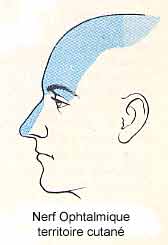Gesret method : cutaneous pathologies of the face
Introduction
Receiving lots of postings and messages on the discussion forum about cutaneous pathologies of the face, this page will answer the questions you all have frequently been asking.
Cutaneous pathologies of the face
All the patients who present an eczema (or other erythematous pathologies: dermitis, psoriasis, etc.) localised on the face, have systematic dental problems. Indeed, there exists a vasodilatation reflex arch between a specific cutaneal zone and a profound nerve root from the trigeminal ganglion.
This cutaneal nervous distribution is perfectly described in neurological papers and (should normally be) is known by all the dermatologists !
When a dental infection occurs, it behaves like an "irritative stitch" on
a nervous fiber who runs to the trigeminal ganglion. An inflammatorial
reaction is produced at the level of the gums, in relation with the
concerned root.
But, even more, by an arch reflex, a secondary inflammatorial reaction
takes place at the level of the cutaneal zone in relation with the same
branch of the trigeminal nerve.
To illustrate my proposition, there is nothing better than some graphics.
 |
 |
| Mandibular root of the trigeminal ganglion (yellow) | Corresponding cutaneal territory. |
 |
 |
| Maxillary root of the trigeminal ganglion (yellow). | Territory of the "butterfly wing". |
 |
 |
| Ofthalmic root of the trigeminal ganglion (yellow) | Corresponding cutaneal territory. |
To know if you have a dental infection
Nothing is more easy:
for the upper teeth (maxillar), open hands upright, handpalms against the face, with the help of your two thumbs, you push against the teeth (at the exterior side of the cheeks), push on an equal way against the gums, on both sides, starting at the side of the wisdom teeth, then the molares, premolares etc...
- for the lower teeth (mandibula) same position of the hands but now you press with the index fingers, the thumbs supported under the cheek, starting from the zone of the wisdom teeth, then the molares, premolares etc...
- If you find a painfull zone during the pressure, there is obligatory an infected zone in the corresponding tooth. Consult a dentist and ask him to examine the tooth because you have a painfull gums, you'll be surprised, and your dentist too, to understand that I am right.
Going a bit further, I affirm that:
I do not say that the cause of the pathology is a dental infection, but I precise that the cutaneal localisation is the motif !
It's allways about a canal infection of a tooth which has been allready serviced, but of which the seal or the crown is not more impenetrable (very old ones), and passing bacteries who provoque an infectious seat in the roots. It passes without notice because the tooth is devitalised and because there is no pain felt, only by pression on the gums.